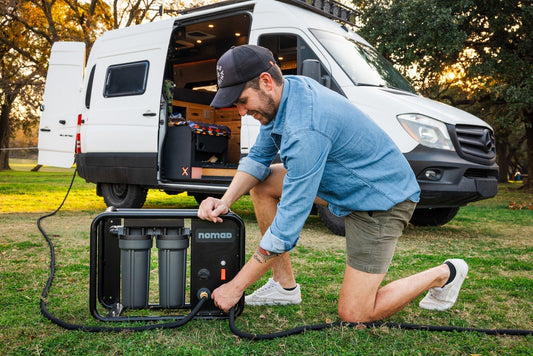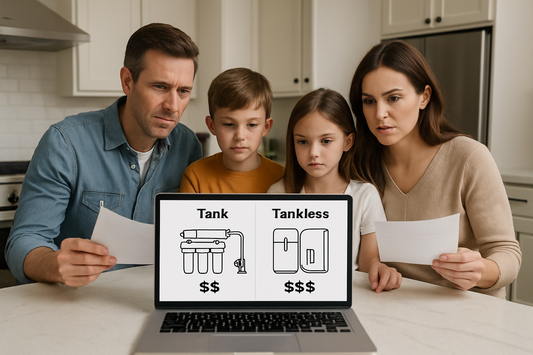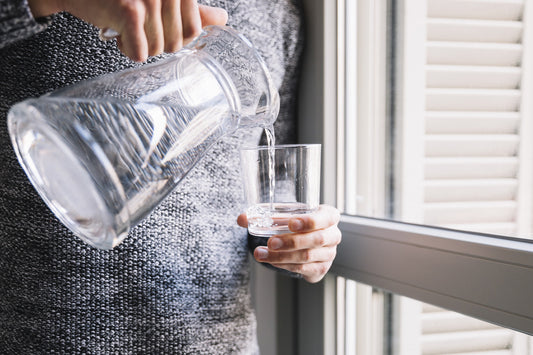Quick Answer: If your water has a metallic taste, unusual odor, discoloration, causes stomach issues, or leaves stains on fixtures, you need immediate testing. Start with simple visual inspection and pH strips, then consider professional analysis if problems persist.
Your tap water should be invisible, odorless, and tasteless. When it's not, your family's health could be at risk. Here are five unmistakable warning signs that demand immediate water quality testing, plus proven methods to protect your household.
5 Critical Warning Signs Your Water Needs Testing
1. Strange Taste or Metallic Flavor
What it means: Metallic tastes often indicate lead, copper, or iron contamination from aging pipes or well water sources. Sweet tastes can signal dangerous lead levels, while salty flavors may indicate water softener malfunctions or natural mineral contamination.
Immediate action: Stop drinking the water and switch to bottled water until testing is complete. Contact a water testing professional within 24 hours.
2. Unusual Odors (Chlorine, Sulfur, or Musty Smells)
What it means: While slight chlorine odor is normal in municipal water, strong chemical smells indicate over-treatment. Sulfur ("rotten egg") odors suggest bacterial contamination common in well water systems. Musty or earthy smells often signal algae or bacterial growth in your water supply.
Immediate action: For sulfur or musty odors, avoid drinking the water and test for bacteria immediately. Strong chlorine smells require municipal water authority notification.
3. Water Discoloration (Brown, Yellow, or Green Tints)
What it means: Brown water typically indicates iron contamination or rusty pipes. Yellow tinting may signal chromium or other mineral contamination. Green discoloration often means copper corrosion in your plumbing system.
Immediate action: Document the discoloration with photos, collect samples in clean containers, and contact your water supplier or well water professional.
4. Frequent Stomach Issues or Unexplained Illness
What it means: If multiple family members experience recurring stomach problems, nausea, or digestive issues, contaminated water could be the culprit. Bacterial contamination, particularly E. coli or coliform bacteria, commonly causes these symptoms.
Immediate action: Switch to bottled water immediately and schedule bacterial contamination testing within 48 hours.
5. Stains on Fixtures, Laundry, or Appliances
What it means: Red-brown stains indicate iron contamination. Blue-green stains suggest copper corrosion. White, chalky buildup signals hard water with excessive calcium and magnesium. These mineral imbalances can damage plumbing and affect water taste.
Immediate action: Photograph the stains and test for mineral content and pH levels to determine appropriate filtration solutions.

Simple DIY Water Testing Methods
Visual and Sensory Assessment (Free - 2 minutes)
Fill a clear glass with cold tap water under good lighting. Quality water should be completely transparent without floating particles, cloudiness, or color. Trust your senses—any detectable taste or smell indicates potential contamination requiring further testing.
pH Testing ($5-15 - 5 minutes)
Use digital pH meters or test strips to measure water acidity. Safe drinking water should measure between 6.5-8.5 pH. Water outside this range can corrode pipes and indicate contamination. This test is especially crucial for well water filter system selection.
Bacterial Contamination Testing ($15-35 - 2-7 days)
Home bacterial test kits detect harmful bacteria like E. coli that indicate sewage contamination. Simply collect water in the sterile container, add testing solution, and monitor for color changes indicating bacterial presence.
Total Dissolved Solids (TDS) Testing ($10-25 - 3 minutes)
Digital TDS meters measure dissolved minerals, salts, and metals. While some minerals benefit health, readings above 500 ppm may indicate contamination and help determine if a crystal quest water filter system is needed.
When Professional Testing is Essential
Immediate professional testing required for:
- Positive bacterial contamination results
- pH levels below 6.0 or above 9.0
- Visible particles or severe discoloration
- Strong chemical odors
- Multiple family members experiencing illness
Professional laboratory analysis costs $100-300 but provides comprehensive testing for dozens of contaminants that home kits cannot detect.

Choosing the Right Water Filtration Solution
For Well Water Contamination: Specialized well water filter systems effectively handle iron, sulfur, bacteria, and sediment common in private wells. These often require pre-filtration stages and UV sterilization components.
For Municipal Water Issues: A comprehensive crystal quest water filter provides multi-stage filtration including sediment removal, carbon filtration, and advanced media to address chlorine, heavy metals, and chemical contaminants.
For Bacterial Problems: UV sterilization systems eliminate 99.99% of harmful bacteria and viruses without adding chemicals to your water supply.
Maintaining Water Quality Long-Term
Replace filter cartridges every 3-6 months according to manufacturer specifications. Overused filters can harbor bacteria and actually worsen water quality. Test annually or immediately when you notice changes in taste, smell, or appearance.
Emergency Water Safety Protocol
If testing reveals serious contamination:
- Switch to bottled water immediately
- Boil water for cooking (note: boiling doesn't remove chemical contaminants)
- Contact water treatment professionals within 24 hours
- Document contamination with photos and test results
- Notify local health authorities for community well or municipal water issues
Frequently Asked Questions
How quickly can water quality change in my home? Water quality can change rapidly due to pipe breaks, contamination events, or seasonal well water variations. Municipal water issues often affect entire neighborhoods simultaneously, while well water problems may develop gradually over months.
Can I rely on municipal water treatment to keep my water safe? While municipal treatment removes many contaminants, aging infrastructure, over-chlorination, and treatment failures can still result in contaminated tap water. Home filtration provides an additional safety barrier for your family.
What's the most dangerous water contaminant I should test for first? Bacterial contamination poses the most immediate health risk, especially E. coli which indicates sewage contamination. Lead testing is equally critical for homes with children, as even trace amounts can cause developmental problems.
How do I know if my well water filter system is working properly? Monitor water taste, smell, and appearance weekly. Test water quality every 6 months and replace filters according to manufacturer schedules. Decreased water pressure or returning odors indicate filter replacement needs.





